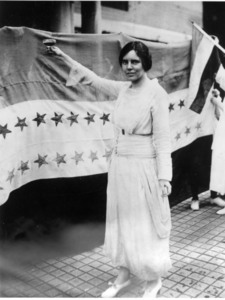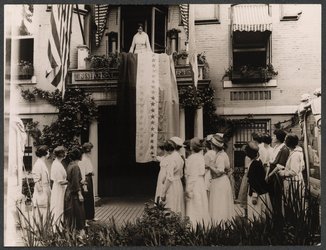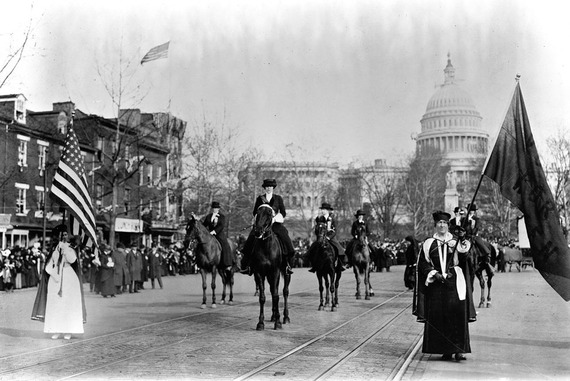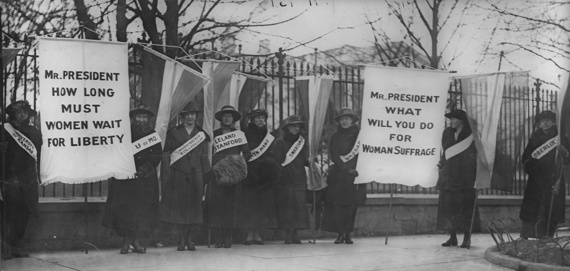This week, Americans will commemorate the 50th anniversary of the landmark Selma-to-Montgomery march, led by Rev. Martin Luther King, and celebrated in the new film Selma, that helped secure the Voting Rights Act of 1965, a major milestone in our nation's history. In doing so, Americans should also recall another important voting rights march that occurred 102 years ago. That march, which took place in Washington, D.C. on March 3, 1913 and was, like the Selma protest, disrupted by angry opponents of freedom and equality, was led by Alice Stokes Paul, the leader of the women's suffrage movement.
Organized by the National American Woman Suffrage Association, the women's suffrage parade took place the day before the inauguration of President Woodrow Wilson. More than 8,000 marchers, mostly women, marched down Pennsylvania Avenue from the Capital to the White House. Half a million spectators -- many of them in Washington for the inauguration -- watched the parade, which included nine bands, four mounted brigades, and 20 floats. Some of the spectators were hostile to the cause of women's right to vote and harassed the marchers -- including tripping and assaulting them -- while the police stood by. More than 100 marchers were hospitalized.
But the protest fulfilled its goal. The parade generated headlines across the country, making the issue of women's suffrage a topic of national conversation and led to congressional hearings. Like the later civil rights movement, the women's march on Washington was part of a broader crusade that included civil disobedience, lobbying, rallies and protests, media outreach, and grassroots organizing. The march helped movement gain momentum, but it took another seven years -- until 1920 -- before the Nineteenth Amendment secured the vote for women.


Alice Paul toasting Tennessee's ratification of the 19th amendment, and standing on the balcony of the National Woman's Party headquarters, unfurling a banner celebrating the victory for women's rights.
All American women who now have the right to vote owe a debt of gratitude to the women's suffrage movement, and to Alice Paul (1885-1977), who dedicated her life to the cause of women's equality. Like King, Paul viewed voting rights as only a step in the direction of full participation and freedom. In 1923, Paul drafted the Equal Rights Amendment, but had to wait almost fifty years -- until 1972 -- before Congress passed it, only to watch it die when too few states ratified it in the wake of a growing conservative backlash.
In the 1930s and 1940s, Paul worked with the League of Nations and then the United Nations to get those institutions to adopt the principle of gender equality. In the 1960s, she spearheaded a coalition that added a sexual discrimination clause to Title VII of the 1964 Civil Rights Act, a landmark law that helped break down many barriers to women's equality.
Who was Alice Paul?
She grew up outside Moorestown, New Jersey, on a 265-acre farm that her family called "Paulsdale," with a large house with indoor plumbing, electricity and a telephone. But, they were not typical farmers. Her father was the president of a bank. Alice and her three younger siblings had some chores to perform, but hired workers did the actual farming, and maids did the cooking and cleaning. But the Pauls were not a typical rich family, either. Although they had many material comforts, they lived quite simply given their wealth.
Alice was descended from Hicksite Quakers, the most liberal and egalitarian wing of Quakers. They believed in gender equality and in working for the betterment of society -- ideals Alice's parents instilled in her from an early age. Paul's mother was a member of the National American Woman Suffrage Association, and sometimes took Alice with her to women's suffrage meetings. Paul attended a Hicksite Quaker school, graduating first in her class in 1901. It was a foregone conclusion that she would attend Swarthmore College, a co-ed Quaker institution that her grandfather, Judge William Parry, had helped start in 1864.
Paul's Swarthmore professors included some of the nation's leading female academics. One of them, math professor Susan Cunningham, liked to say, "Use thy gumption." Much of Paul's political life could be summarized by those words.
After graduating from Swarthmore, Paul earned a master's degree in sociology at the University of Pennsylvania. In 1907, she moved to England to practice social work among the poor at a Quaker-run settlement house in Birmingham. One day she heard a speech by Christabel Pankhurst, the daughter of Emmeline Pankhurst, the leader of the radical wing of England's feminist movement. Paul was intrigued by the Pankhursts' motto, "Deeds not words," which they translated into direct action, including heckling, rock throwing and window smashing, to draw attention to the cause of women's rights. Not surprisingly, the women often got arrested for such protests, which led to newspaper photos of activists being carried away in handcuffs by the police.
Hesitant at first to join their militant crusade, Paul eventually overcame her fears and was arrested and jailed several times. In prison, she and other suffragettes protested their confinement with hunger strikes. Their jailers force-fed them. Paul took solace in a motto that one of her fellow activists carved into the prison wall: "Resistance to tyranny is obedience to God."
When Paul returned to the United States in 1910, she was determined to inject the radical ideas she had learned in England into the women's rights movement. While earning her Ph.D. in economics at the University of Pennsylvania (her dissertation examined women's legal status), she joined the National American Woman Suffrage Association (NAWSA). At the suggestion of Jane Addams -- the founder of the settlement house movement and a leading progressive activist -- Paul was soon appointed head of the committee responsible for working for a federal women's suffrage amendment.
In 1912, she moved to Washington, D.C., and joined forces with Lucy Burns, another American, whom she had met when they were both arrested in a London suffrage protest. They hatched the idea for the protest parade the day before President Wilson's swearing-in ceremony. Although Wilson had showed some interest in the women's cause, he said the time was not yet right. Paul never believed that Wilson was the least bit sympathetic to women's suffrage. He would only support them, she thought, if public opinion compelled him to.
In this and other respects, Paul disagreed with NAWSA leaders. They endorsed Wilson, despite his opposition to women's suffrage, hoping they could eventually convince him. They worried that Paul's tactics could trigger a backlash. They also disagreed with Paul's emphasis on winning a federal amendment. The NAWSA's main focus was on winning women the vote one state at a time, hoping to build momentum that could later lead to a federal constitutional change. By 1912, however, only nine states had granted women the vote.
Like the later civil rights movement, in other words, the crusade for women's suffrage had its own internal differences. But in reality, the two strategies complemented each other: Even if the amendment was passed by Congress, it would have to be ratified in the states, where NAWSA was building its base.
But the broader disagreements led to a split. Paul and her followers first formed the Congressional Union in 1914, which became the National Woman's Party (NWP), an organization that recruited women prepared to engage in direct action. The NWP published a weekly paper and staged demonstrations, parades, mass meetings, picketing, hunger strikes, and lobbying vigils. Suffragists released from prison, wearing prison uniforms, rode a "Prison Special" train, speaking throughout the country.
Paul's critics called her a fanatic. Her loyal followers considered her a self-sacrificing heroine who inspired women to take risks for the cause. She was a charismatic figure who not only had incredible leadership skills, but also was a gifted administrator, a rare combination. Despite her Quakerism, however, she reflected some of the attitudes of her upper-class background, including prejudices against Jews and African-Americans. The NWP was overwhelmingly white, middle class and Protestant.
Starting in January 1917, the NWP organized "silent sentinels" -- activists standing outside the White House holding banners asking, "Mr. President, what will you do for suffrage?" and "Mr. President, how long must women wait for liberty?" Over the next eighteen months, more than 1,000 women picketed, including Alice, every day except Sunday. Wilson initially patronized the protesters, tipping his hat to them when he passed by. But when the United States entered World War I, the president and others became irate over the idea of women picketing outside the White House while the nation was at war. Angry mobs attacked the protesters, and police began arresting them on the trumped-up charge of obstructing traffic.
Sent to a prison in Virginia, Paul and her colleagues adopted the tactics she had learned in England. They demanded to be treated as political prisoners and staged hunger strikes. Their jailers beat them and confined them to cold, unsanitary, rat-infested cells.
The press reported on the suffragists' terrible experiences in prison, and politicians and activist groups demanded their release. The public outcry played a role in Wilson's decision in 1917 to reverse his stance and announce his support for a suffrage amendment. He explained that it was a "war measure" -- to stop the controversy over women's rights from dividing the country during wartime.
But it was not until the war was over, in 1919, that both the House and the Senate passed the Nineteenth Amendment. Because the suffrage movement had invested heavily in state-level campaigns, its leaders were confident they could garner the three-fourths of the states needed to ratify the amendment. By the summer of 1920, they needed just one more state to vote in favor. The Tennessee legislature met in August 1920 to vote on the issue. The deciding vote was cast by Harry Burn, at twenty-four the youngest member of the Tennessee assembly. He initially intended to vote "no" but changed his vote after receiving a telegram from his mother asking him to support women's suffrage. Women finally gained the right to vote seventy-two years after the women's suffrage movement began.
Unlike many suffragists, however, Paul viewed the victory as simply a stepping stone toward fuller women's equality. In 1923 she announced a campaign for another constitutional amendment that read, simply, "Men and women shall have equal rights throughout the United States and every place subject to its jurisdiction." What became known as the Equal Rights Amendment (ERA) split the women's movement. The League of Women Voters, the National Consumers League, the Women's Trade Union League, and other women's groups opposed the ERA on the grounds that it would abolish protective labor legislation for women.
With Paul's backing, the ERA was introduced in every session of Congress after 1923. In 1944 both the Republicans and the Democrats included the ERA in their party platforms. When Congress began debating the Civil Rights Act of 1964, Paul helped lead a coalition to add the word "sex" to Title VII, which banned discrimination in employment. Few members of Congress understood the importance of adding just that single word.
In 1972, when Paul was eighty-seven, the new women's movement got Congress to adopt the ERA, but only thirty-five states -- three short of the number needed -- ratified the amendment. By then, Paul, who had been out of the limelight for many years, had become a heroine to the new generation of feminists. Today, however, she is largely forgotten among the general public, despite her central role in building a movement that won voting rights for women. In 2004, HBO broadcast made-for-TV film, Iron Jawed Angels, about the women's suffrage movement, starring Hilary Swank as Paul, Frances O'Connor as Lucy Burns and Anjelica Huston as activist Carrie Chapman Catt, but the movie had little impact.
Alice Paul deserves to be remembered as a major figure in American history and, despite her prejudices, as a role model for young activists. Shortly before Paul's death, a Newsweek reporter asked the veteran activist to explain her remarkable perseverance in the struggle for women's rights. She recalled an adage she had learned from her mother while she was growing up on the family farm: "When you put your hand to the plow, you can't put it down until you get to the end of the row."
Peter Dreier is professor of politics and chair of the Urban & Environmental Policy Department at Occidental College. His most recent book is The 100 Greatest Americans of the 20th Century: A Social Justice Hall of Fame (Nation Books, 2012)


